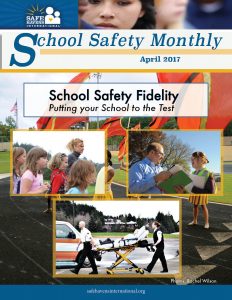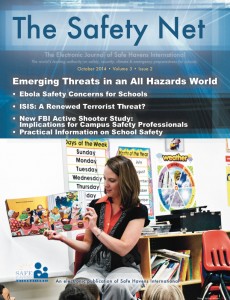Mass casualty school shootings are neither a new phenomenon nor a problem unique to American schools. We do need to improve safety, security and emergency preparedness. At the same time, we must remember to use evidence-based practices focused on addressing real risk. For example, over the past several years we have seen numerous lockdown, barricade, and door locking devices enter the market. Since the Parkland shooting last week we have seen a new device invented by a high school student – the “JustinKase” – go viral.

Over the past several years a number of dangerous tactics and equipment have been suggested, including one politician’s recommendation that students carry canned food to keep under their desk as a weapon against gunmen.
Door Locking Devices and Barricade Tools
Like programs that teach students to throw books and other objects at a gunman with a semi-automatic rifle, many of these door locking devices are well intended. One major drawback is that many of these devices are also very costly. Education budgets are already stretched too thin to waste tens of thousands of dollars if it is not justified. In many cases, lockdown devices are not needed if building equipment is used properly. While many schools do have older door hardware, most schools built within the last 10 to 20 years that are still in good condition would not need a lockdown device or door barricade device to rapidly protect classroom occupants from a threat in the hallway or outside the school.
Like many devices we see, it appears that the JustinKase device would likely violate fire codes because it cannot be easily manipulated with one hand to exit and because it would delay egress. It also appears that the JustinKase could even be used as a bludgeon.
We are more concerned that the device does not appear to have a way for school officials or first responders to bypass it. This would make it easy for a student or visitor to trap a staff member, or other students, in a room and attack or sexually assault them while preventing rescuers from entering the room (these types of events are far more common than active shooters). A similar concern is that other types of assaults have occurred when attackers locked out help. In one case we worked, a school registrar was beaten into a coma by a 67-year-old woman who first locked the office door from the inside.
Some barricade lockdown devices do allow entry to the room with a proprietary key. However, from our experience working Active Shooter cases, rapid response teams may not be able to wait for these during a fast-breaking incident. They may, in turn, need to resort to extreme measures to breach the room. In the Arapahoe High School shooting in 2013, some doors had to be cut open using a blowtorch because there were not enough master keys readily available. If you use a barricade device, you should have a very reliable system for staff and law enforcement to obtain rescue keys rapidly.
Any lockdown device should be reviewed by your Fire Marshall first to make sure it will not violate fire code. Some devices delay egress or might make escape impossible for some building occupants. One device that is particularly concerning when used in schools is a metal device that goes over the door closer arm, preventing it from opening. This would be difficult or impossible for first responders to breach and many students (and some staff) would be too short to remove it from the door arm, thus preventing egress. Additionally, a person in a wheelchair or with other physical limitations would not be able to operate or remove the device. For more on avoiding lockdown device letdowns, read our October 2016 newsletter: “Improving School Lockdowns”.
Unless your school already has leading-practice student threat evaluation and management and suicide prevention teams, you are more likely to have an attack and to be successfully sued for failure to meet the standard of care. This is even more true if funding was used on these types of devices.
School Violence is Not New and U.S. Schools are Actually Safer Now Than in Decades Past
We continually hear about the days when mass casualty school attacks did not happen. On the contrary, U.S. history provides many examples of horrific attacks from colonial times to the present. School shootings predate the Civil war. The first mass casualty American school shooting was in 1891 when five students were shot in a Newburgh, New York parochial school. The 24/7 news cycle and the internet make us painfully and almost instantly aware of incidents that previously would not receive national attention.
As with child molestation and drunk driving, today we are far more aware of homicides in K12 schools than we were in decades past. In fact, the homicide rate has continually decreased. For example, the two most deadly attacks in American schools both occurred more than 50 years ago:
1958: A troubled elementary child kills 95 students and staff with a book of matches at the Our Lady of Angels Sacred Hearts school in Chicago.
1927: A school board member carries out a deadly shooting and bombing of the Bath School in Michigan, killing more than 40 students, staff and town officials.
There is no region of the world that has not been touched by school violence. Attackers have used firearms, knives, gasoline, swords, clubs, hatchets, explosives, a homemade flamethrower and other weapons to carry out mass casualty school attacks around the globe as far back as 1764. China has had attacks where dozens have been killed by a single attacker with a knife.
Focus on Proven Solutions Rather Than Knee-Jerk Responses
Though pundits, special interest groups, vendors, elected officials and individuals with the very best of intention suggest an array of simple solutions, there are actually no examples of the elimination of mass casualty weapons violence. At the same time, we cannot lose sight of the fact that many planned school shootings are successfully averted for every successfully carried out attack. Just a day before the Parkland attack, an even more terrifying attack plan was thwarted in Washington State along with many other potential acts of K12 violence across the country.
There are no simple answers or 100% effective approaches to prevent school shootings. There are approaches that have been used to successfully avert hundreds of planned school shootings. Working in this field for decades, it is frustrating to see a school ignore proven measures that have prevented deadly school shootings and bombings for decades. While door locking devices may be useful or even necessary in some schools, other types of threats are more common. As we look at our active shooter response measures, we stay vigilant on student threat assessment and management, behavioral training approaches and suicide prevention. When schools engage in theoretical approaches that are not validated, it creates a serious risk to our students and those who educate them.

